Korean cuisine is world-renowned for its diverse and flavorful side dishes known as banchan. These small dishes play a crucial role in Korean meals, offering a variety of tastes and textures that complement the main courses. From salads to stir-fried vegetables, banchan showcases Korea’s rich culinary traditions.
Why are Korean side dishes so important? They provide balance and enhance the flavors of the entire meal. Each side dish offers a unique experience, whether it’s a spicy kick, a sweet note, or a savory touch. These dishes not only satisfy the palate but also highlight the importance of fresh ingredients and careful preparation in Korean cooking.
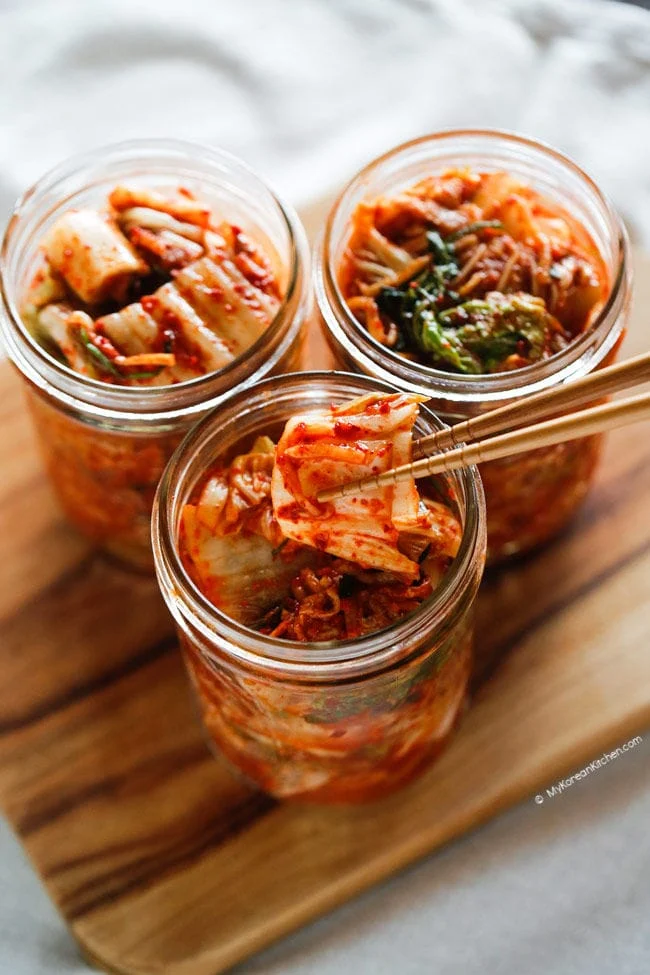
1) Kimchi
Kimchi is one of the most iconic Korean side dishes. It’s a fermented vegetable dish, most commonly made with napa cabbage and Korean radishes. Fermentation gives kimchi its signature tangy and spicy flavor.
You can find many varieties of kimchi, each with unique ingredients and seasoning. Common seasonings include chili pepper, garlic, ginger, and jeotgal (salted seafood). These ingredients play a big role in developing its complex taste.
Kimchi is not only delicious but also known for its health benefits. It is packed with vitamins A, B, and C and is also rich in probiotics, which are good for your digestive system. It’s a great side dish for almost any Korean meal.
Many people enjoy kimchi fresh, but it can also be eaten aged. The flavor of aged kimchi becomes more intense and robust. Kimchi is versatile and can be used in various dishes like kimchi jjigae (stew), kimchi fried rice, and kimchi pancakes.
Making kimchi at home can be a fun and rewarding experience. There are plenty of recipes available that cater to different tastes and preferences. You can adjust the spice level and fermentation time to suit your palate.
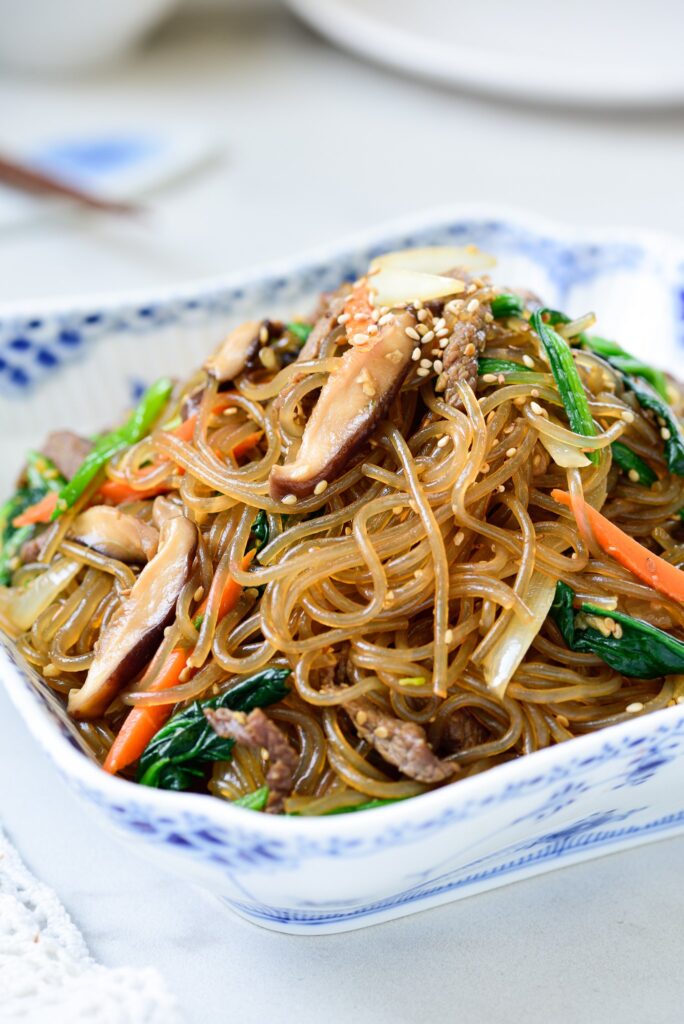
2) Japchae
Japchae is a popular Korean side dish made from sweet potato starch noodles, also known as glass noodles or dangmyeon. These noodles are stir-fried with various vegetables, often including spinach, carrots, bell peppers, and onions.
The preparation starts with boiling the glass noodles until they become soft and translucent. Typically, this takes about six minutes. Once cooked, the noodles are drained and rinsed in cold water to cool them down.
Next, the vegetables are stir-fried separately. It’s important to cook each type of vegetable just enough to retain their crunch and vibrant colors. Commonly used vegetables include julienned carrots, sliced onions, and bell peppers.
The key to a great Japchae is the sauce. You will need to mix Korean soy sauce, sugar, sesame oil, chopped garlic, and toasted sesame seeds. This sauce adds a savory and slightly sweet flavor to the noodles.
After preparing the noodles and vegetables, combine them in a large mixing bowl. Pour the sauce over the mixture and toss everything together until well coated. You can also add sliced mushrooms or beef for extra flavor.
Serve Japchae at room temperature or slightly warm. It’s a versatile side dish that complements a variety of main dishes and can also be enjoyed on its own.
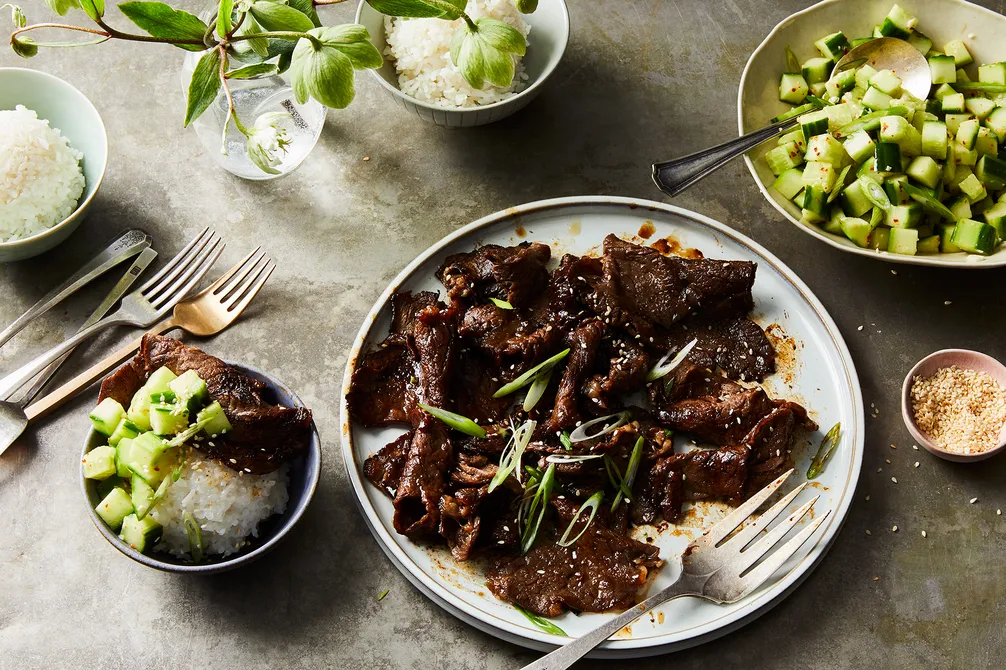
3) Banchan
In Korean cuisine, banchan refers to small side dishes served along with cooked rice. These dishes are often shared among everyone at the table and can include a variety of vegetables, meats, and fermented items.
Common banchan items include kimchi, seasoned spinach, and stir-fried vegetables. Each dish is prepared with unique spices and seasonings that contribute to the overall meal’s flavor.
Banchan is not just about taste; it’s also about the presentation and variety. You will often find a colorful array of dishes on the table, making the meal visually appealing.
One popular banchan is Mu Saengchae, a sweet and sour radish salad. It’s made with julienned radish, vinegar, sugar, and chili flakes, offering a refreshing and spicy kick.
Another favorite is Hobak Jeon, pan-fried zucchini. It’s simple to make using zucchini, flour, egg, and salt, but it adds a delicate taste to the meal.
Enjoying banchan is an integral part of experiencing Korean food culture. These side dishes enhance the main course and provide a balanced diet with different textures and flavors.
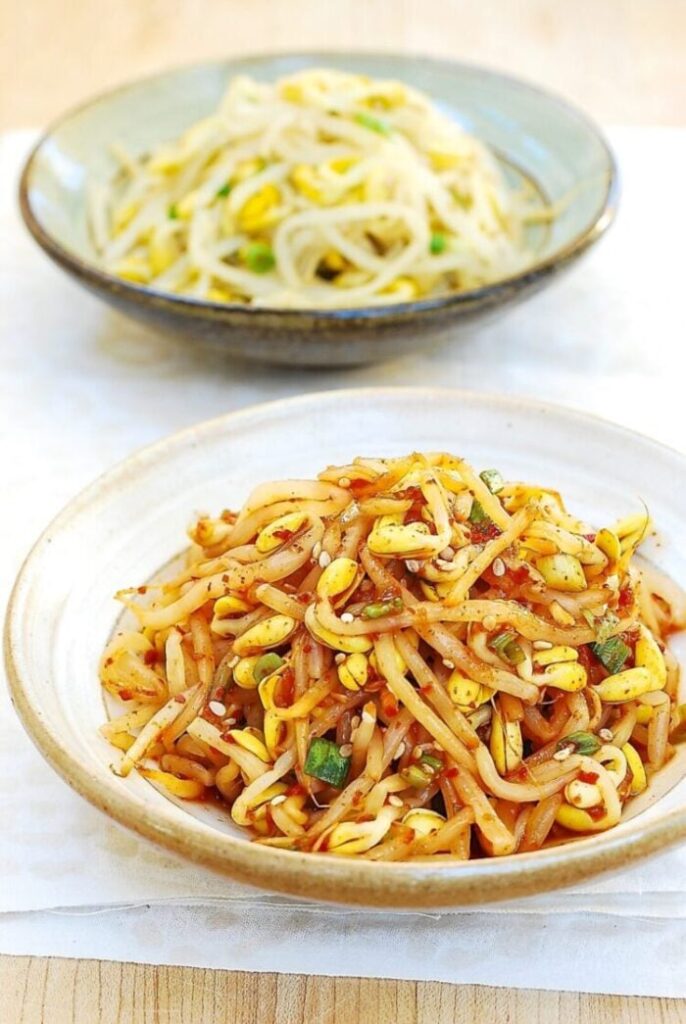
4) Kongnamul
Kongnamul is a popular Korean side dish made from soybean sprouts. This dish is known for its light, fresh taste and crunchy texture.
To prepare Kongnamul, you first rinse the soybean sprouts in cold water, discarding any rotten beans or skins. Then, place the sprouts in a pot with water and bring it to a boil.
Make sure to cover the pot and let it cook for 3 to 8 minutes, depending on the recipe. Keeping the lid closed helps maintain the flavor and aroma of the sprouts.
After cooking, drain the water and transfer the sprouts to a mixing bowl. You can season them with garlic, green onions, sesame seeds, and sesame oil.
Kongnamul can be served cold or at room temperature. It pairs well with rice and other main dishes, making it a versatile addition to any meal. This side dish is not only delicious but also healthy, providing plenty of vitamins and minerals.
Enjoy Kongnamul as a refreshing part of your next Korean meal.
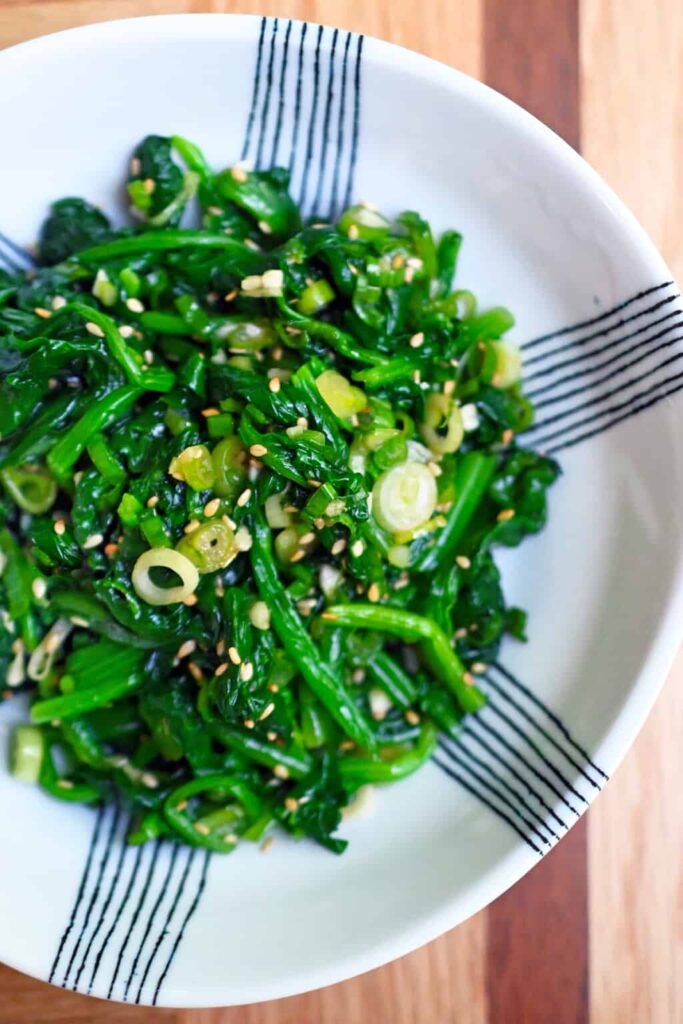
5) Sigeumchi Namul
Sigeumchi Namul is a simple and healthy Korean side dish made with spinach. It is often served with rice and other dishes in Korean meals.
To make Sigeumchi Namul, start by trimming the roots from the spinach. Wash the spinach thoroughly in cold water to remove any dirt or sand.
Next, blanch the spinach in boiling salted water for 20 to 30 seconds until it wilts. Quickly move it to an ice water bath to stop the cooking process. Drain the spinach well and gently squeeze out any excess water.
Cut the spinach into bite-size pieces and place it in a mixing bowl. Add chopped green onions, minced garlic, sesame oil, and salt. Mix everything well to make sure the seasoning is evenly distributed.
Taste a piece of the spinach and adjust the seasoning if needed. You can add a little more salt or sesame oil based on your preference.
Sigeumchi Namul can be served immediately or stored in the refrigerator for a couple of days. It is a nutritious addition to any meal.
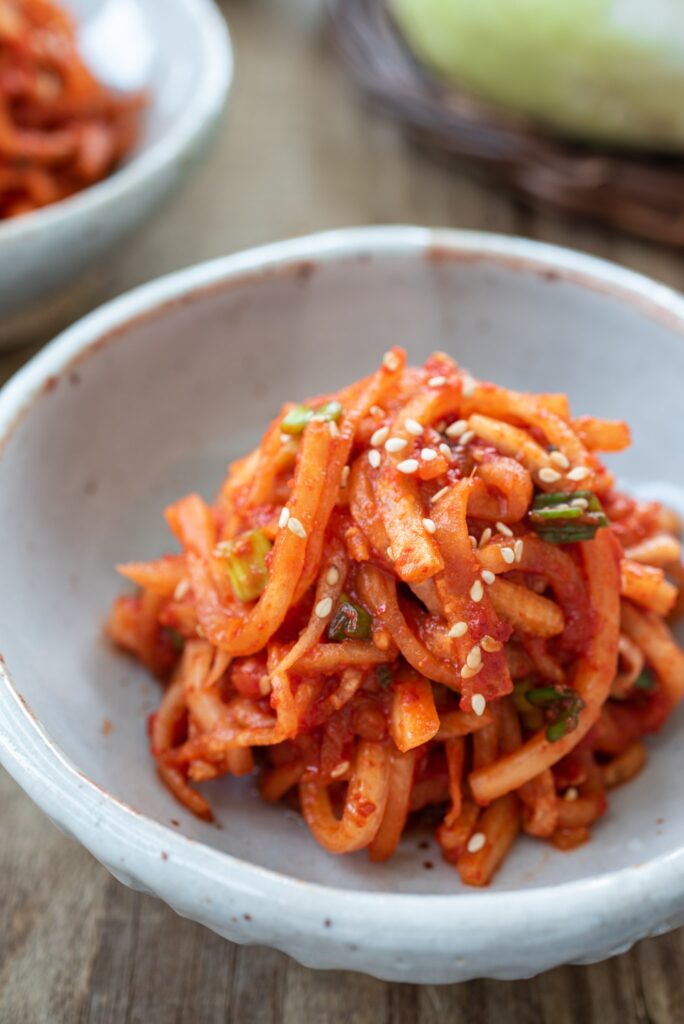
6) Mu Namul
Mu Namul is a simple and tasty Korean radish side dish. You start by cutting the radish into thin sticks or strips.
In a large skillet, heat a tablespoon of oil over medium heat. Add the radish sticks, a bit of soup soy sauce, salt, and minced garlic. Stir well and cook for 4-5 minutes until the radish becomes soft and see-through.
Next, add 1/4 cup of water to the skillet. Lower the heat to medium-low, cover the skillet, and let it cook for another 3-4 minutes.
Once done, add a few drops of toasted sesame oil. Mix everything gently to get a flavorful dish that pairs well with rice and other main courses. This side dish is light, healthy, and perfect for everyday meals.
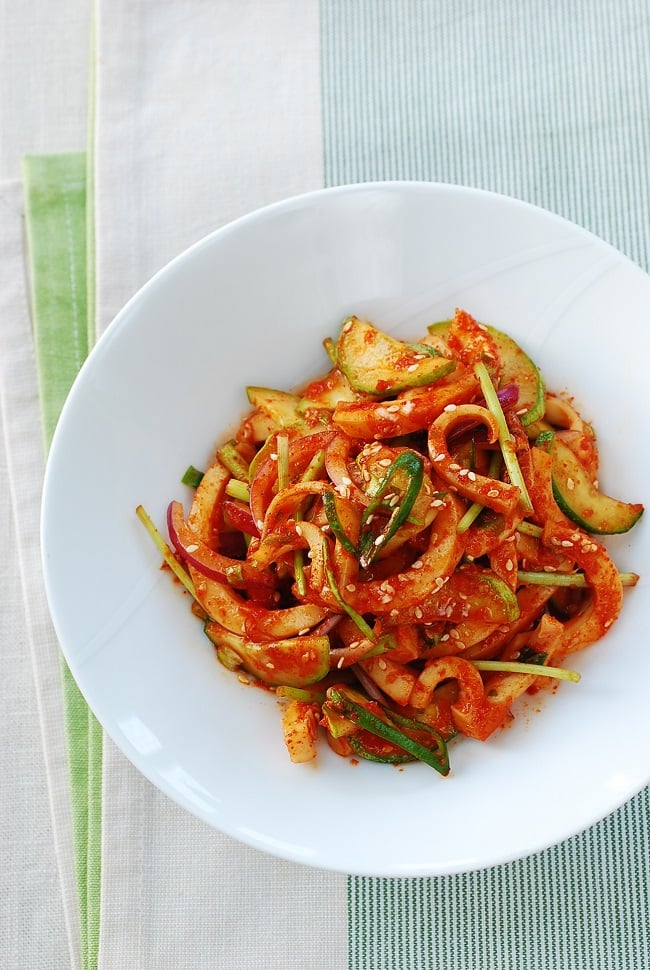
7) Ojingeo Muchim
Ojingeo Muchim is a popular Korean side dish made from fresh squid. This dish is often served chilled and has a spicy, tangy flavor.
First, slice the squid into thin bite-sized pieces. The strips should be about ⅓-inch thick and 2 inches long. Keep these strips in the fridge to cool.
Next, prepare the vegetables. Common choices include carrots, cucumbers, and onions, all cut into thin slices. These add a refreshing crunch to the dish.
Combine all your sauce ingredients in a bowl. You’ll need chili pepper paste, minced garlic, sugar, vinegar, and soy sauce. Mix these well to make a spicy and flavorful sauce.
Combine the squid and the sauce in a large bowl. Mix until the squid is coated evenly. Then, add the sliced vegetables and toss everything together. Adjust the seasoning to taste by adding more sugar, salt, or vinegar.
Ojingeo Muchim is ready to serve. Enjoy it cold, straight from the fridge. This dish pairs well with steamed rice and other Korean side dishes.
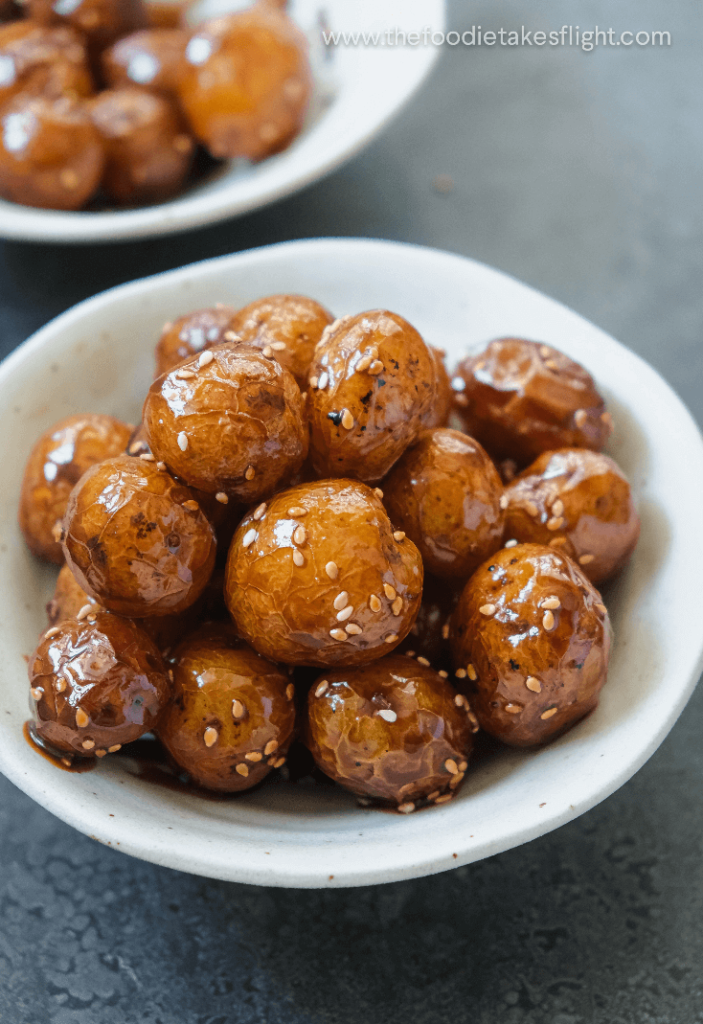
8) Gamja Jorim
Gamja Jorim, or Korean braised potatoes, is a popular side dish in Korean cuisine. It consists of baby potatoes cooked in a flavorful sauce until tender and coated.
Start by peeling and cutting the potatoes into bite-sized pieces. Rinse them to remove excess starch.
Heat cooking oil in a pot over medium heat. Add the potatoes and sauté for a few minutes until they start to turn golden brown. This step helps the potatoes absorb the flavors better.
Prepare the braising sauce by mixing soy sauce, rice syrup, garlic, and other ingredients in a bowl. Once the potatoes are ready, pour the sauce over them.
Cover the pot and let the potatoes simmer on low heat. Stir occasionally to ensure they cook evenly and absorb the sauce.
When most of the sauce has been absorbed, add honey, sesame oil, and sesame seeds. Stir well and cook for a few more minutes.
Gamja Jorim is now ready to serve. It’s a perfect balance of sweet and savory flavors, making it a delightful addition to your meal.
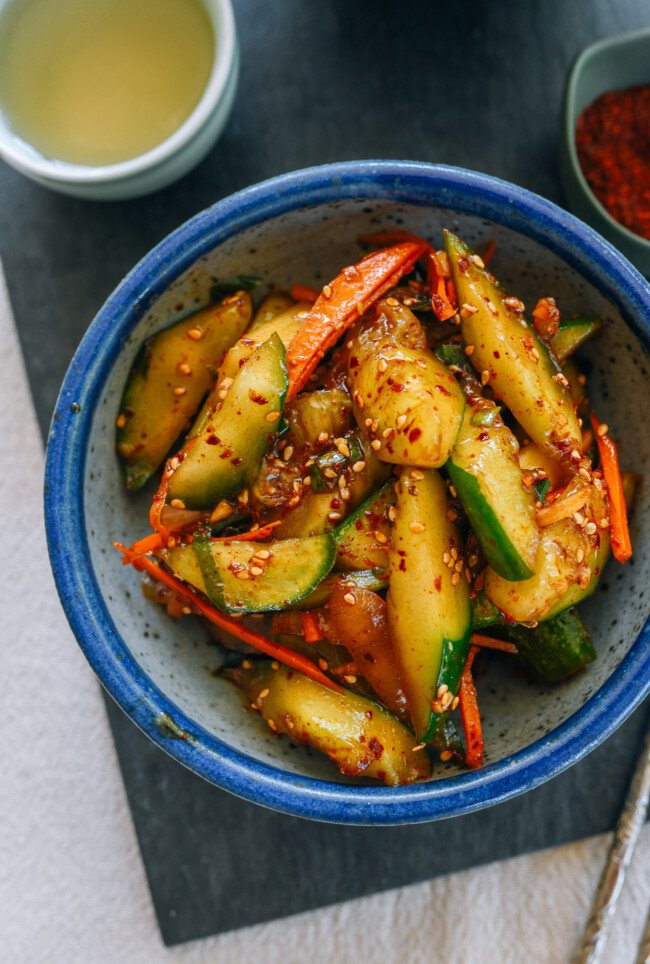
9) Oi Muchim
Oi Muchim, or spicy cucumber salad, is a refreshing Korean side dish. It’s quick to make and pairs well with many main dishes. You start by slicing cucumbers thinly, about 1/8 inch thick. This helps the cucumbers absorb the flavors better.
First, lightly salt the cucumber slices. Let them stand for about 15 minutes to draw out excess water. This step is important as it keeps the salad from becoming too watery.
Next, prepare the seasoning. Mix soy sauce, vinegar, sugar, chili powder, and sesame seeds in a bowl. Toss the cucumbers with this mixture. Add sliced onions and green onions for extra flavor.
Be sure to rinse the cucumbers in cold water after salting and pat them dry. This removes any remaining salt. The onions should also be soaked in ice water for a bit to reduce their sharpness.
Once mixed, let everything sit for a few minutes so the flavors can blend. Serve Oi Muchim chilled for the best taste. This dish is perfect with rice, noodles, or barbecue. It adds a spicy and tangy crunch to your meal.
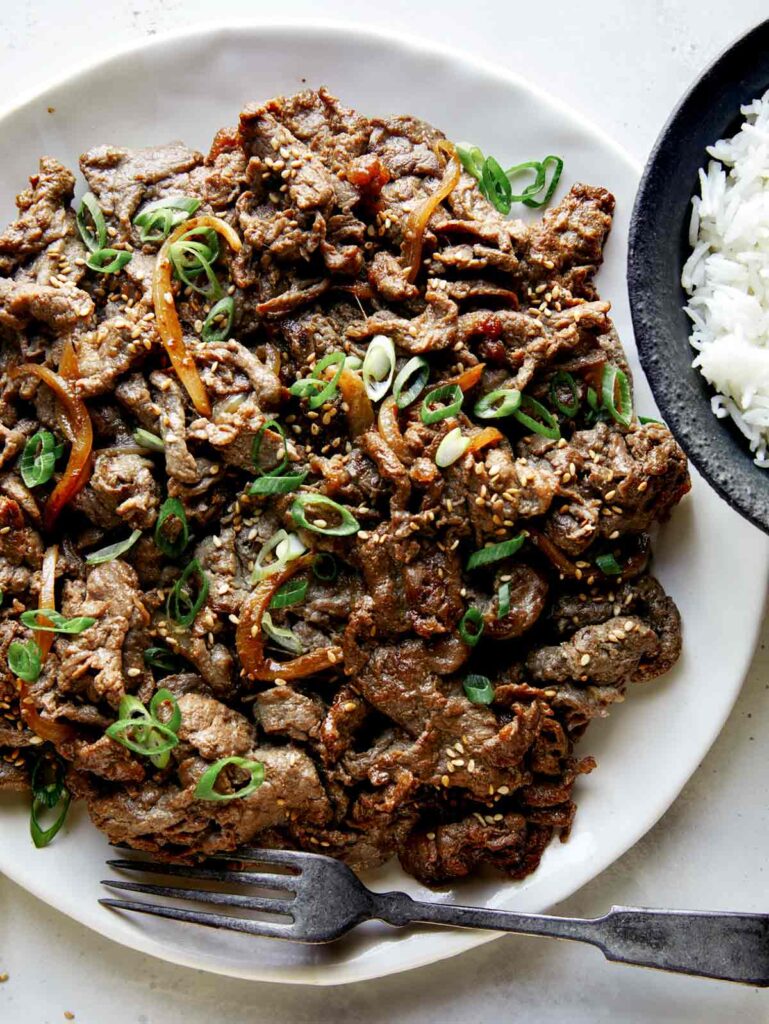
10) Bulgogi
Bulgogi is a popular Korean dish made from thinly sliced beef marinated in a savory-sweet sauce. The marinade usually includes soy sauce, sugar, sesame oil, garlic, and green onions.
You usually grill or stir-fry the marinated beef until it’s tender and slightly caramelized. This cooking method brings out the flavors and makes the beef juicy and flavorful.
You can serve bulgogi with steamed rice or wrap it in lettuce leaves. Adding kimchi or pickled vegetables on the side enhances the overall taste experience.
For an authentic touch, try to use traditional Korean ingredients like gochujang (Korean red chili paste) in the marinade. This adds a hint of spiciness to the dish.
Combining bulgogi with side dishes such as japchae (stir-fried glass noodles) or a simple cucumber salad can make your meal more balanced and interesting.
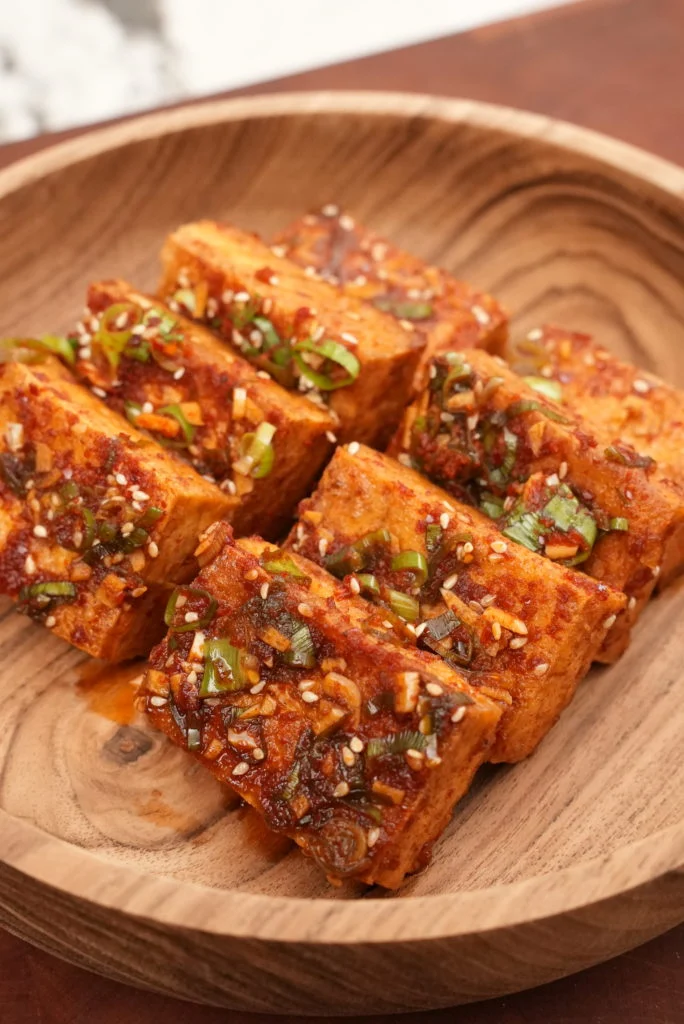
11) Dubu Jorim
Dubu Jorim is a popular Korean side dish made from tofu. It features tofu that is braised in a flavorful soy sauce-based mixture.
To prepare Dubu Jorim, you start by slicing tofu into bite-sized pieces. These pieces are then seared in a pan until they turn golden brown. This step gives the tofu a nice texture.
Once the tofu is seared, it is braised in a sauce made from soy sauce, garlic, and other seasonings. This cooking process allows the tofu to absorb the flavors of the sauce.
Dubu Jorim is often served with rice and other side dishes. It is a great source of plant-based protein and is enjoyed by many for its savory taste.
This dish is simple to make and can be a delicious part of your Korean meals. It is an excellent option if you are looking for a tasty, nutritious side dish.
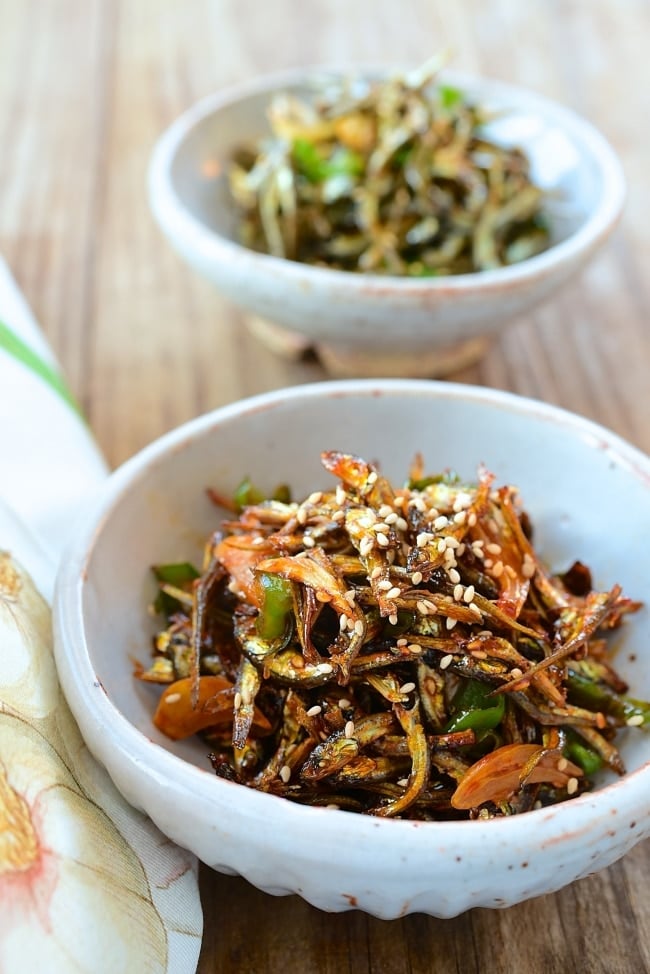
12) Myeolchi Bokkeum
Myeolchi Bokkeum, or stir-fried anchovies, is a popular Korean side dish. It features small dried anchovies that are usually stir-fried with garlic, soy sauce, and a bit of sugar.
To prepare, you start by heating a skillet over medium heat and adding some oil. Then, toss in the garlic and stir for about 10 seconds.
Next, add the dried anchovies to the skillet. Stir them for a few minutes until they turn light brown and crunchy.
Optionally, you can add some peanuts or chili peppers for extra flavor and texture. These ingredients give the dish a delightful crunch.
Towards the end of cooking, you might mix in some sesame oil and sesame seeds for a nutty finish.
Myeolchi Bokkeum is often enjoyed with rice and complements many meals perfectly. Its salty and slightly sweet flavor makes it a versatile side dish.
You can find variations of this dish, some using spicy gochujang sauce if you prefer a bit of heat.
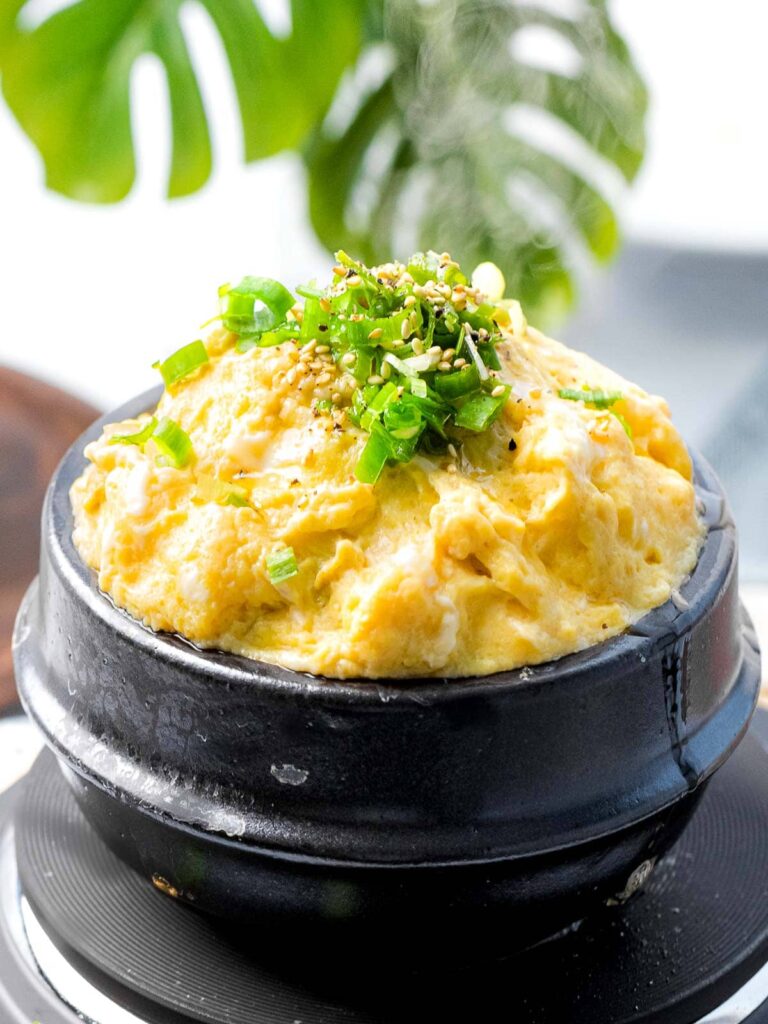
13) Gyeran Jjim
Gyeran Jjim is a popular Korean side dish made from eggs. The name comes from the Korean words “gyeran,” meaning egg, and “jjim,” which refers to steaming.
This dish is very easy to make. You typically start by whisking eggs with water or broth for added flavor. The mixture is often seasoned with salt and sometimes soy sauce. Chopped green onions or other vegetables can be added for extra taste.
To cook Gyeran Jjim, pour the egg mixture into a heat-resistant bowl. You can use a traditional earthenware pot for an authentic touch. Then, steam the mixture until it forms a soft, custard-like texture.
You can steam the dish in various ways. Some people use a microwave to speed up the process. Others prefer the stove for a more traditional method. Either way, the goal is to get a fluffy, fully-cooked egg custard.
Top with sesame oil and toasted sesame seeds before serving. This adds a nice nutty flavor. Gyeran Jjim is best enjoyed warm and can accompany any meal of the day. Its simplicity and rich taste make it a beloved dish in Korean cuisine.

14) Hobak Julienne
Hobak Julienne is a simple and delightful Korean side dish. It features thinly sliced zucchini, cooked to perfection with a few basic ingredients. The zucchini’s natural sweetness shines through, making it a great addition to any meal.
To make Hobak Julienne, start by cutting the zucchini into thin matchstick-like strips. This helps them cook quickly and evenly.
In a pan, heat some oil over medium heat. Once the oil is hot, add the garlic and stir for a few seconds until it’s fragrant. Then add the zucchini strips.
Cook the zucchini, stirring often, for about 2-3 minutes. You want them to soften but still retain a bit of crunch. Season with salt or fish sauce for extra flavor.
Some variations include adding a splash of soy sauce or sesame oil for a richer taste. Gochugaru (Korean red pepper flakes) can be added for a bit of spice.
Finally, sprinkle some toasted sesame seeds on top before serving. This adds a nice texture and extra nutty flavor. Enjoy your Hobak Julienne with rice or as part of a larger meal.
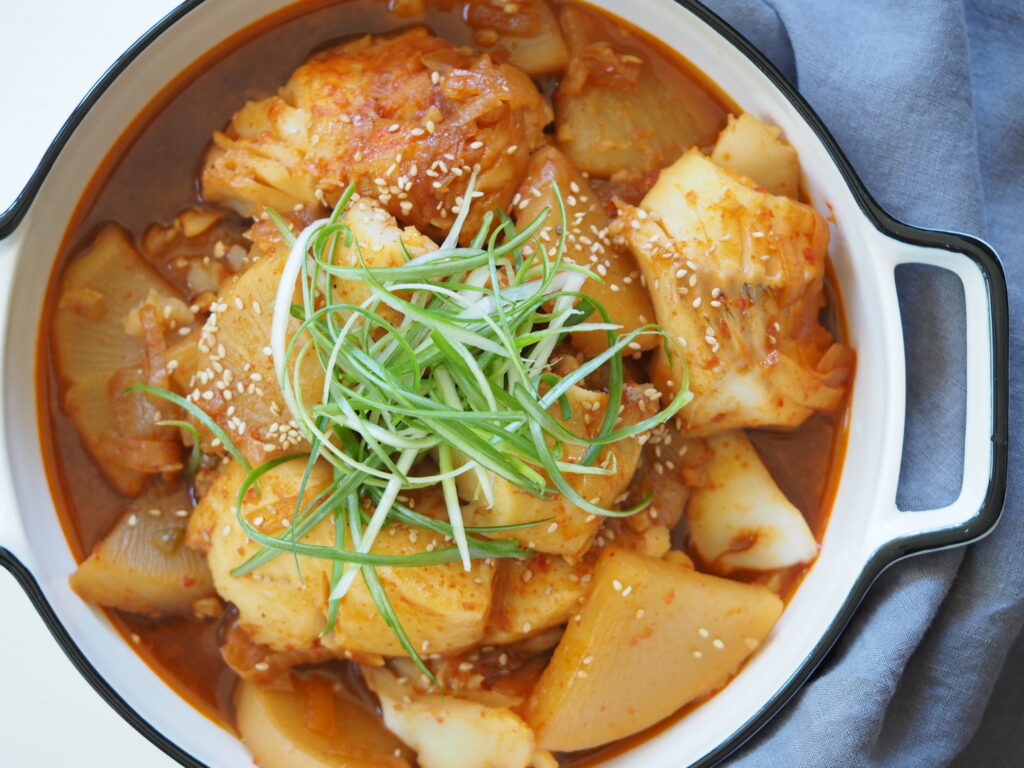
15) Saengsun Jorim
Saengsun Jorim is a delicious Korean braised fish dish. It features fish cooked in a flavorful soy-based sauce. Common choices for the fish include mackerel, cod, or even sea bass.
The sauce is made by combining soy sauce, garlic, ginger, and a bit of sugar. You also add vegetables like radish and onion. This adds extra flavor and nutrition.
To make this dish, first marinate the fish in the sauce for a short time. Then, you simmer the fish and vegetables together until cooked through. The sauce thickens and coats everything nicely.
Saengsun Jorim pairs well with rice. This makes it perfect for a balanced meal. It can be enjoyed hot or at room temperature. This adds convenience for busy meals.
This dish is popular in Korean households. It showcases the country’s rich culinary traditions. Saengsun Jorim is both healthy and satisfying. The combination of tender fish and savory sauce is truly enjoyable.
Cultural Significance of Korean Side Dishes
Korean side dishes, known as banchan, reflect Korea’s rich history and play a key role in meals. They are more than just food; they embody tradition, culture, and social habits.
Historical Context
Banchan has deep roots in Korean history, dating back to the mid-Three Kingdom period (around 300s AD). At this time, Buddhism influenced Korean cuisine, discouraging meat consumption. As a result, vegetables became the focal point of many dishes.
Over centuries, these side dishes evolved, influenced by different cultural exchanges and local resources. Despite changes, banchan remained true to using seasonal ingredients. This tradition showcases Korea’s deep connection to its agricultural practices.
Role in Korean Meals
Banchan is central to the Korean dining experience. They are served in small portions, often as numerous dishes, creating a varied and flavorful meal. They are typically placed in the center of the table to encourage sharing.
These side dishes highlight the importance of balance in Korean cuisine—balancing flavors, textures, and nutrients. This approach not only makes each meal diverse but also promotes a sense of community by encouraging communal eating.
Each type of banchan adds a different element to the meal, whether it’s the tangy crunch of kimchi or the savory taste of stir-fried vegetables. This variety ensures that every meal is unique and exciting, truly reflecting the Korean spirit of togetherness and hospitality.
Ingredients Commonly Used in Korean Side Dishes
When crafting Korean side dishes, you often use a variety of vegetables and fermented ingredients to enhance flavors and textures. These ingredients are vital in making the dishes both unique and delicious.
Vegetables and Herbs
Korean side dishes often feature a wide array of fresh vegetables. Commonly used vegetables include cucumbers, zucchini, radishes, spinach, and eggplants. These vegetables provide a variety of textures and flavors, from the crispness of cucumbers to the sweetness of zucchini.
Herbs like garlic, green onions, and perilla leaves are also key. Garlic and green onions add depth to many dishes, while perilla leaves offer a distinct, slightly minty flavor.
Leafy Greens such as spinach and watercress are often blanched or stir-fried, then seasoned with soy sauce, sesame oil, and sesame seeds.
Fermented Ingredients
Fermented ingredients are essential in Korean cooking. Gochujang (fermented red chili paste) and doenjang (fermented soybean paste) are two of the most frequently used.
Gochujang adds both heat and a subtle sweetness to dishes, while doenjang provides a rich umami flavor.
Another staple is kimchi, made from cabbage or radishes, which offers a tangy, spicy kick.
Jeotgal (salted fermented seafood) is used in small amounts to enhance savory flavors in side dishes.
These fermented ingredients not only enhance the flavors but also introduce beneficial probiotics, making the food both tasty and healthy.








